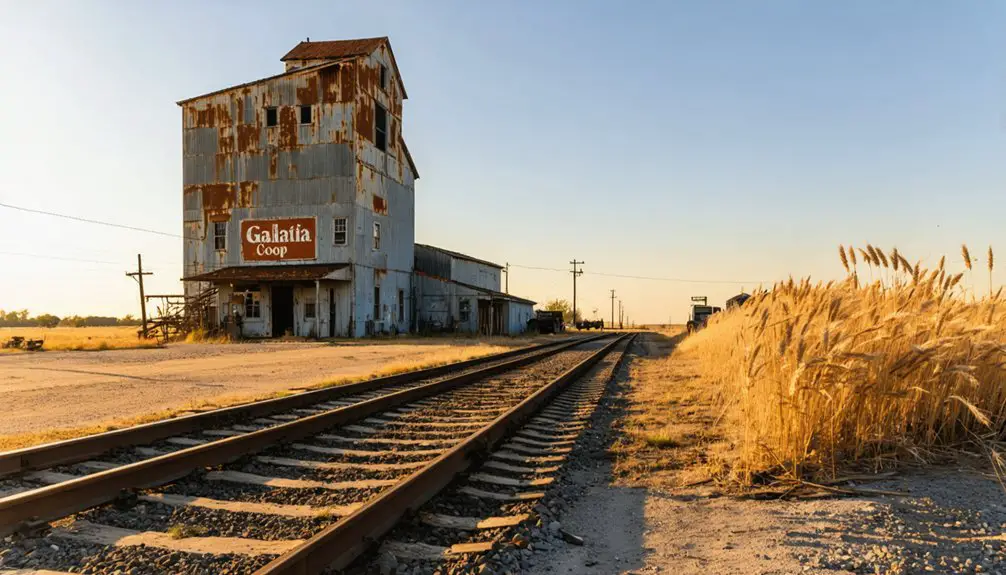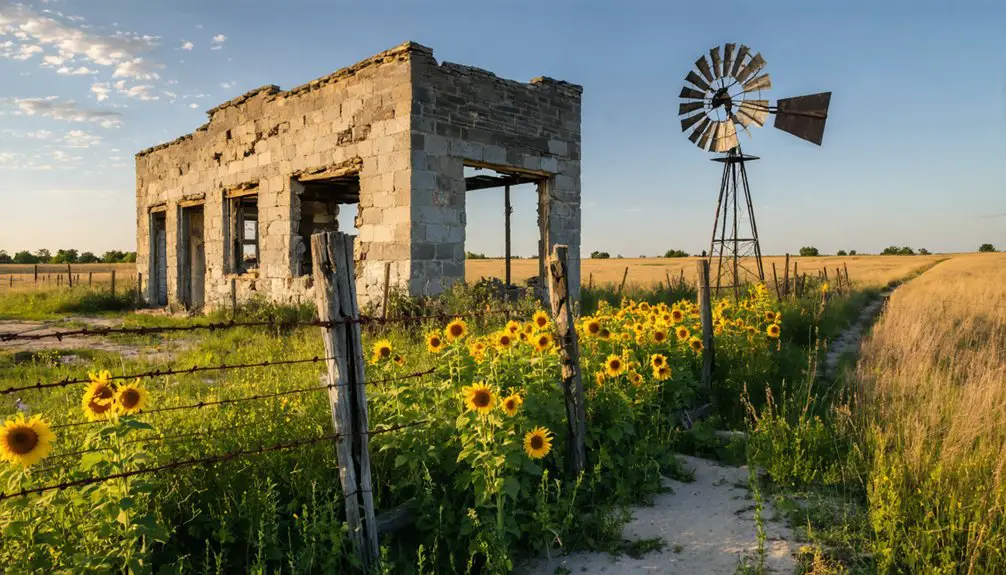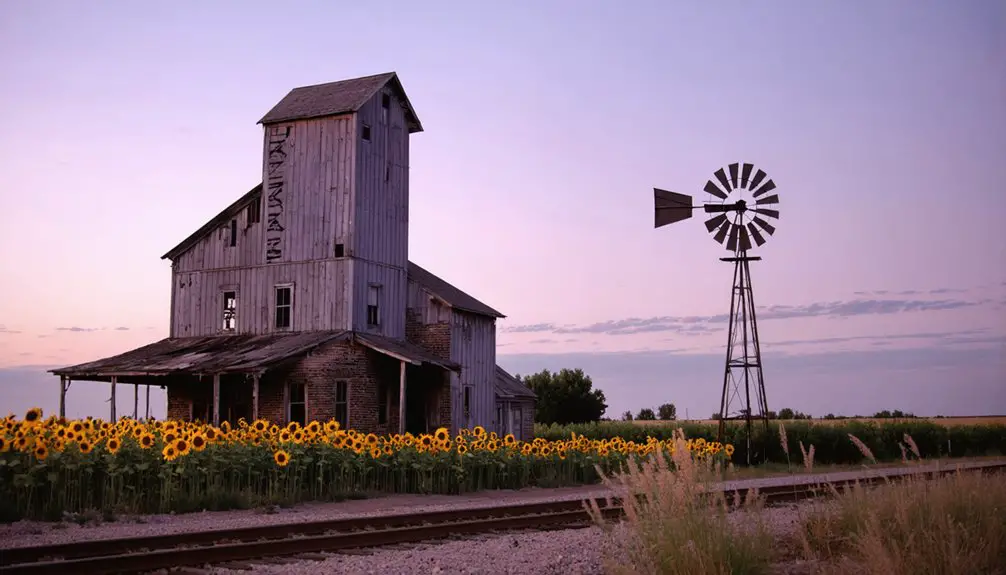You’ll find Galatia’s ghost town remnants in central Kansas, where settlers first established farms in 1870 before David C. Barrows laid out the town site in 1885. Initially called Dogtrot, then Four Corners, this prairie railroad hub reached its peak of 202 residents in 1921, boasting three grain elevators, a bank, and various stores. Agricultural mechanization between 1920-1960 sparked its decline, though Fairview Cemetery and an old Lutheran church still mark this once-bustling community’s legacy.
Key Takeaways
- Galatia’s population declined from 202 residents in 1921 to 60 by 1980, transforming it from a thriving town into a ghost town.
- The town lost critical services including its post office in 1966 and schoolhouse, forcing residents to seek essential amenities elsewhere.
- Mechanization of farming between 1920-1960 reduced labor needs, leading to farm consolidation and population exodus from Galatia.
- Only a few historic structures remain today, including Fairview Cemetery, an old Lutheran church, and an active farmer’s co-op.
- Originally established in 1885, Galatia flourished as a railroad hub until agricultural mechanization and service losses led to its decline.
Early Settlement and Town Origins
While several settlers had already established farms in the area by 1870, Galatia’s formal beginnings emerged in 1885 when David C. Barrows laid out the original town site.
Long before Galatia took shape, pioneering farmers cultivated these lands, until David C. Barrows formally established the town in 1885.
The settler experiences in this northwestern portion of Barton County included early pioneers like J. Renake, H. Shultz, W.W. Halsey, and Charles Rowdebush, who arrived in the early 1870s.
You’ll find the town’s evolution reflected in its various names – first known as Dogtrot, then Four Corners, before Henry G. Weber, who came from Galatia, Illinois, gave it its permanent name.
The community quickly established its foundations with the construction of a United Brethren church as its first permanent structure, followed by a post office in 1889, serving the diverse mix of German, Czech, Bohemian, and Russian immigrants. Much like the ancient Galatians who became Hellenized over time, these immigrant groups gradually integrated into the local culture.
The arrival of the railroad in 1916 brought new opportunities for growth and commerce to the developing town.
Railroads and Transportation Development
The Atchison, Topeka and Santa Fe Railway’s expansion into Galatia in 1916 marked a pivotal moment in the town’s development, with the line’s official extension completed by 1919.
You’ll find that this railroad connection transformed Galatia into a significant mail distribution hub, with its post office serving surrounding farms and settlements from 1889 to 1966.
The Santa Fe line’s presence sparked the construction of essential infrastructure, including grain elevators, a bank, and three general stores that supported the town’s peak population of 202 residents by 1921. Much like its ancient namesake in central Anatolia, this Kansas settlement became an important regional center for its time. Similar to how J.A. Hitschmann allowed railway expansion through his farmland, local landowners facilitated the railroad’s growth in Galatia.
Santa Fe Line Expansion
Following its early focus on westward expansion, Santa Fe Railway began an aggressive growth strategy in 1879 to dominate Kansas transportation routes and protect its interests from emerging competitors. The railway strategically offered free land grants to settlers along its routes to drive development and traffic. You’ll find that their route optimization included strategic southern extensions through towns like Frontenac and Pittsburg, while securing essential eastern terminals and western connections to California. This competition led to intense rate wars over cattle, with shipping costs plummeting from $40 to just $10 per carload.
Mail Distribution Hub Changes
Santa Fe Railway’s expansion through Kansas brought significant changes to Galatia’s role as a mail distribution center. When Galatia’s post office opened in 1889, it served as a crucial hub for surrounding farms and settlements along the Santa Fe Trail. The arrival of the railway line from Holyrood in 1919 initially strengthened the town’s mail route evolution, making it a notable regional center with busy grain elevators and general stores.
However, you’ll find that the postal service shift gradually worked against Galatia’s interests. As railway networks consolidated and motor vehicle transport gained prominence, mail distribution moved to larger towns with better highway access.
The town’s diminishing population, from 202 residents in 1921 to fewer than 60 by 1980, paralleled its declining importance as a mail hub, culminating in the post office’s closure in 1966.
Economic Growth and Peak Years
Established alongside the Missouri Pacific Railroad in 1885, Galatia quickly emerged as an essential trading hub for Austrian settlers and other European immigrants in Barton County, Kansas.
A strategic railroad settlement in Kansas that became vital to European immigrants seeking prosperity in America’s heartland.
The town’s development accelerated when the Santa Fe Railroad arrived in 1916, positioning Galatia as a crucial endpoint for regional trade routes.
During its peak years around 1921, you’d have found a thriving community of 202 residents supported by robust economic sustainability.
The town boasted three grain elevators, multiple general stores, a bank, and a lumber yard. These businesses served both the local population and surrounding agricultural community. Like many small farming towns of the era, Galatia relied on small local farms to sustain its economy. Similar to Bell Plane’s orchards, agriculture was the economic foundation that supported the community’s growth.
The railroad’s presence made Galatia an important distribution point for mail, grain shipments, and necessary goods, while farmers’ cooperatives helped strengthen the region’s agricultural economy.
Daily Life in Early Galatia
Life in early Galatia centered around its religious and educational institutions, with the United Brethren church serving as the town’s first building and spiritual anchor.
You’d find community gatherings at the Lutheran church and cemetery, while the two-room schoolhouse buzzed with youth engagement and educational activities.
Your daily routines would’ve revolved around the farmer’s co-op, three general stores, and the post office, which connected you to the wider world.
After the railroad’s arrival in 1919, you’d see increased activity at the grain elevators and bank.
The town’s diverse population, including German, Czech, and Russian immigrants, shaped the cultural fabric of daily life.
At the lumberyard, you’d witness the constant work of building and maintaining the growing community.
Agricultural Impact and Community Changes

You’ll find Galatia’s transformation from thriving farm community to ghost town closely tied to the 1920s-1960s mechanization era, when improved machinery and hybrid seeds allowed fewer farmers to work larger acreages.
Like many small Kansas towns, Galatia faced significant population decline over the past century, mirroring the widespread demographic shifts that shaped the region.
The town’s farmer’s co-op and three grain elevators once served as essential agricultural trading hubs, connecting local producers to broader markets via the Santa Fe rail lines.
As farms consolidated and families moved away, Galatia’s population plummeted from 202 residents in 1921 to just 60 by 1980, leaving abandoned storefronts where farming supplies, hardware, and groceries were once sold.
Farm Mechanization Era Changes
During the mid-20th century, the arrival of mechanized farming equipment transformed Galatia’s agricultural landscape and social fabric.
You’d see tractors, plows, and harvesters replacing traditional manual tools and animal-drawn implements across the Kansas prairie. This shift to farm machinery drastically reduced the need for farmhands and led to the consolidation of smaller family farms into larger operations. Before mechanization, women and children were essential laborers in Kansas farming operations.
The impact of mechanization reached far beyond the fields.
You’ll find that rural depopulation hit Galatia hard as fewer farming families needed to live near local service centers. The town’s decline accelerated when farms became more self-sufficient and operations were increasingly managed from urban areas.
Cooperative Farming’s Local Impact
While mechanization transformed Galatia’s farming practices, the local farmer’s cooperative emerged as an important institution that helped sustain the community’s agricultural backbone. The cooperative benefits extended beyond mere economics – you’d find farmers pooling resources for equipment, securing better prices on supplies, and accessing shared grain storage facilities. This collective approach proved essential for maintaining farm profitability in Barton County’s challenging markets.
You could see the cooperative’s impact on community resilience through its role as a gathering place where farmers exchanged knowledge and strengthened social bonds. The organization supported critical local institutions and provided informal credit to members during planting and harvest seasons.
Through Kansas Farmers Union influence and state agricultural extension services, Galatia’s cooperative helped modernize farming practices while preserving the town’s agricultural heritage.
Lost Agricultural Trading Hub
Once a bustling agricultural nexus known as Dogtrot, Galatia’s transformation into an essential trading hub began with its 1889 post office establishment and peaked following the Santa Fe Railroad’s arrival in 1916.
You’ll find Galatia’s legacy in its agricultural innovations, from the three grain elevators that revolutionized crop storage to the farmers’ co-op that strengthened trade partnerships.
The town’s merchant scene thrived with general stores and lumber yards serving regional farmers, while its strategic position at the endpoint of major railroad lines connected local harvests to national markets.
German, Czech, Bohemian, and Russian settlers brought diverse farming methods that shaped the region’s agricultural identity.
The Decline of Essential Services

The closure of Galatia’s post office in May 1966 marked a pivotal moment in the town’s decline, signaling the deterioration of its essential services.
You’d no longer find the bustling hub that once connected local residents to the outside world through mail and community gatherings.
The town’s two-room schoolhouse, which had educated generations of local children, shuttered its doors, forcing families to send their kids to nearby Hoisington for education.
Without its own newspaper and with diminishing infrastructure, Galatia’s role as a service center continued to fade.
The loss of these essential services created a domino effect, pushing more residents to seek opportunities elsewhere.
What remained was a shell of the former community, stripped of the basic amenities that once made it a thriving rural center.
Cultural Heritage and Social Memory
Immigrant settlers from diverse European backgrounds shaped Galatia’s rich cultural tapestry from its earliest days. German, Czech, Bohemian, and Russian families brought their traditions, forming a unique community identity that you can still trace through local cultural preservation efforts.
Religious institutions played a crucial role in maintaining immigrant identity, with the Lutheran and United Brethren churches serving as cultural anchors.
Today, these spaces continue to tell Galatia’s story through:
- Historic church buildings reflecting European architectural influences
- Well-maintained cemeteries documenting family histories and settlement patterns
- Oral histories collected from former residents and their descendants
You’ll find echoes of this heritage in the farming practices, cooperative structures, and social frameworks that emerged from the blending of these immigrant cultures, creating a distinctly American prairie town experience.
Modern Day Remnants and Landmarks

Modern Galatia’s physical remnants tell a story of gradual decline, with only a handful of historic structures still dotting the 0.4-square-mile landscape.
You’ll find Fairview Cemetery and an old Lutheran church standing as historic landmarks, preserving the town’s earliest memories. The farmer’s co-op remains active, maintaining an essential link to the area’s agricultural heritage.
While you won’t find any original schools or businesses operating today, the town’s community identity persists through rustic signage and local markers. A playful “Slow Men Playing” sign captures the rural spirit, while minimal remnants of the old railroad and limestone quarry hint at past prosperity.
The surrounding prairie farmland continues to define Galatia’s character, even as nearby towns like Hoisington now serve as regional hubs.
Legacy of a Prairie Railroad Town
Founded as a railroad terminus in 1919, Galatia emerged as an essential transportation hub when the Atchison, Topeka and Santa Fe Railway extended its line 31.20 miles from Holyrood.
You’ll find echoes of Galatia’s vibrant past in the stories of community events and religious gatherings that once defined this prairie town’s spirit.
As a centerpiece of regional commerce, Galatia’s influence extended far beyond its modest size:
- Three grain elevators, a bank, and multiple general stores transformed the town into a bustling marketplace for farmers.
- The United Brethren church and Lutheran congregation served as anchors for religious gatherings and social life.
- The post office, operating until 1966, connected scattered homesteads and facilitated essential communication across Barton County’s rural expanse.
Frequently Asked Questions
Are There Any Ghost Stories or Paranormal Activities Reported in Galatia?
You won’t find documented ghost sightings or haunted locations in this town’s records. While it has abandoned buildings and a historic cemetery, there’s no verified evidence of paranormal activity.
What Natural Disasters or Significant Weather Events Affected Galatia’s History?
You’ll find that tornado occurrences threatened the area regularly, while severe storms and devastating drought during the 1930s Dust Bowl hit hardest. Blizzards and extreme weather frequently disrupted local farming and transportation.
Did Any Notable Crimes or Infamous Incidents Occur in Galatia?
You won’t find notable crimes or infamous incidents in Galatia’s history – available records and archives don’t reveal any significant criminal events that impacted this small farming community’s story.
What Native American Tribes Originally Inhabited the Galatia Area?
You’ll find that the Pawnee and Kaw (Kanza) tribes were the primary native tribes of historical significance in your area, with their territories overlapping the central Kansas region around Galatia’s future location.
Were There Any Local Festivals or Annual Celebrations Unique to Galatia?
While you might picture bustling local traditions, there’s no documented evidence of unique festivals in this railroad town. Church gatherings and community events centered around religious services were the main social occasions.
References
- https://fhsuguides.fhsu.edu/kansasheritage/bartoncounty
- https://lostkansas.ccrsdigitalprojects.com/sites/lostkansas/files/private_static/2022-12/LT_BT_Dogtrot-Galatia_Schmidt.pdf
- https://legendsofkansas.com/kansas-ghost-town-list/
- https://www.youtube.com/watch?v=5UTFd2JlelY
- http://kansasghosttowns.blogspot.com/2015/10/a-story-of-hitschmann-kansas-dead-town.html
- https://en.wikipedia.org/wiki/Galatia
- https://kids.kiddle.co/Galatia
- https://en.wikipedia.org/wiki/List_of_Kansas_railroads
- http://old.atsfrr.org/resources/burton/sk.htm
- https://denversrailroads.com/ATSF.htm



